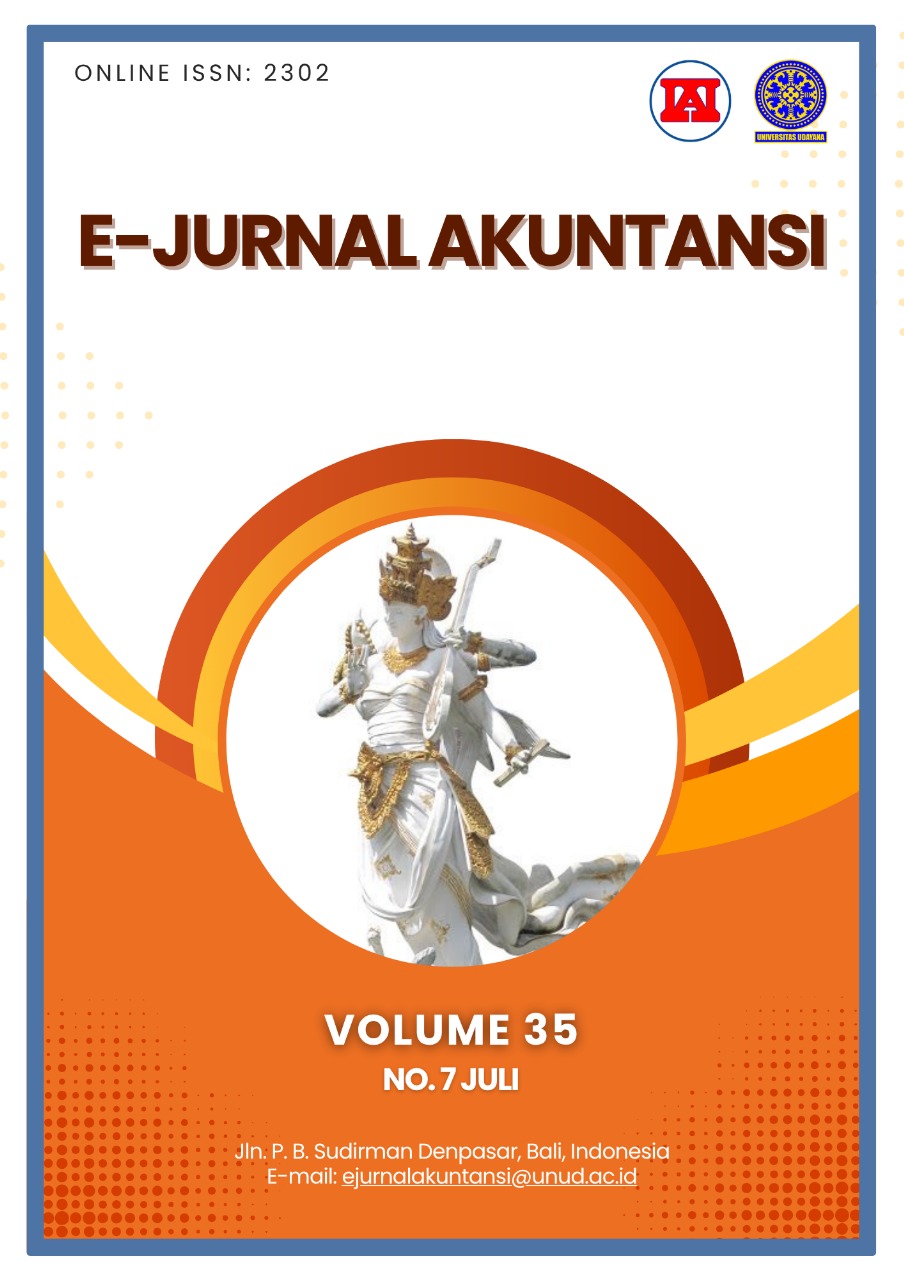Application of UTAUT 2 Model on E-Filing Usage Behavior
Abstract
The research conducted has a focus on knowing the factors that influence the intention and behavior of using e-Filing through the application of the UTAUT 2 Model. This research was conducted at Denpasar Barat and Denpasar Timur Tax Office. The sampling method used is purposive sampling with a sample of 100 respondents who have met the criteria as a sample. Structural Equation Model-Partial Least Square is used for data analyzing. The findings obtained indicate that the intention to use e-Filing is supported by business expectations, socio-cultural factors, beliefs and is not supported by habits and usage intentions.
Keywords: UTAUT 2; e-Filing; Intention; Usage Behavior
Downloads
References
Alalwan, A. A., Dwivedi, Y. K., & Rana, N. P. (2017). Factors influencing adoption of mobile banking by Jordanian bank customers: Extending UTAUT2 with trust. International Journal of Information Management, 37(3), 99–110. https://doi.org/10.1016/j.ijinfomgt.2017.01.002
Alharbi, S. (2017). An extended UTAUT model for understanding of the effect of trust on users’ acceptance of cloud computing. International Journal of Computer Applications in Technology, 56(1), 65–76. https://doi.org/10.1504/IJCAT.2017.086562
Ariyanto, D., Subroto, B., Purnomosidhi, B., & Rosidi. (2014). Does the Balinese Tri Hita Karana Culture Affect the Adoption and Usage of Information Technology Systems? Information and Knowledge Management, 4(9), 150–160.
Aswani, R., Ilavarasan, P. V., Kar, A. K., & Vijayan, S. (2018). Adoption of public WiFi using UTAUT2: An exploration in an emerging economy. Procedia Computer Science, 132, 297–306. https://doi.org/10.1016/j.procs.2018.05.180
Brown, S. A., & Venkatesh, V. (2005). Model of Adoption of Technology in Household: A Baseline Model Test and Extension Incorporating Household Life Cycle. Mis Quarterly, 29(3), 399–426.
Carter, L., & Bélanger, F. (2005). The utilization of e-government services: Citizen trust, innovation and acceptance factors. Information Systems Journal, 15(1), 5–25. https://doi.org/10.1111/j.1365-2575.2005.00183.x
Deameta, A. F. (2019). Prediksi Intensi Perilaku terhadap Penggunaan Mobile Bangking Menggunakan The Unified Theory of Acceptance and Use Of Technology, Trust, Dan Network Externalities. Jurnal Akuntansi, Audit Dan Sistem Informasi Akuntansi, 3(2), 205–217.
Dewi, A. A. P. P., Wirakusuma, M. G., & Gayatri, G. (2022). Pengukuran Keberhasilan Penggunaan Internet Banking di Bank Rakyat Indonesia Kota Denpasar. E-Jurnal Akuntansi, 32(2), 3608. https://doi.org/10.24843/eja.2022.v32.i02.p02
Dewi, N. P. K. L. R. K., & Yadnyana, I. K. (2017). Faktor-Faktor Yang Memengaruhi Minat dan Perilaku Penggunaan Sistem E-Filing Di Kota Denpasar dengan Model UTAUT. E-Jurnal Akuntansi, 21(3), 2338–2366. https://doi.org/10.24843/EJA.2017.v21.i03.p23
Dewi, N. P. N. T., & Setiawan, P. E. (2020). Analisis Penggunaan E-Filing oleh Wajib Pajak Orang Pribadi dengan Menggunakan UTAUT 2. E-Jurnal Akuntansi, 30(12), 3081. https://doi.org/10.24843/eja.2020.v30.i12.p07
Dewi, S. I. K., Kurniadi, D., & Sriwahyuni, T. (2018). Analisis Tingkat Penerimaan Dan Penggunaan Aplikasi Evaluasi PBM Menggunakan Model UTAUT (Unified Theory of Acceptance and Use of Technology) yang Diperluas Di Universitas Negeri Padang. Voteteknika (Vocational Teknik Elektronika Dan Informatika), 6(1). https://doi.org/10.24036/voteteknika.v6i1.10430
El-Masri, M., & Tarhini, A. (2017). Factors affecting the adoption of e-learning systems in Qatar and USA : Extending the Unified Theory. Educational Technology Research and Development. https://doi.org/10.1007/s11423-016-9508-8
Gupta, A., & Dogra, N. (2017). Tourist adoption of mapping apps: A UTAUT2 perspective of smart travellers. Tourism and Hospitality Management, 23(2), 145–161. https://doi.org/10.20867/thm.23.2.6
Hidayat, M. T., Aini, Q., & Fetrina, E. (2020). Penerimaan Pengguna E-Wallet Menggunakan UTAUT 2 (Studi Kasus). Jurnal Nasional Teknik Elektro Dan Teknologi Informasi, 9(3), 239–247. https://doi.org/10.22146/.v9i3.227
Indrawati, & Putri, A. P. (2020). Analyzing Factors Influencing Continuance Intention of E-Payment Adoption Using Modified UTAUT 2 Model. 2020 8th International Conference on Information and Communication Technology, ICoICT 2020, 0(c), 167–173.
Jufri, M. (2022). Analisis Faktor-Faktor Yang Memengaruhi Keinginan Wajib Pajak Dalam Menggunakan E-Filing Di Kota Batam. Jurnal Teknologi Dan Sistem Informasi Bisnis, 4(1), 107–115. https://doi.org/https://doi.org/10.47233/jteksis.v4i1.384 ISSN
Mugni, N. N., & Rikumahu, B. (2019). Analisis Niat Perilaku Pengguna E-Money Berbasis Chip Menggunakan Model Modifikasi UTAUT. Jurnal Mitra Manajemen, 3(5), 614–627.
Nugroho, N. W., Winarno, W. W., & Putro, H. P. (2021). Evaluasi Tingkat Penerimaan Masyarakat terhadap Aplikasi Jogja Istimewa menggunakan Modifikasi Unified Theory of Acceptance and Use of Technology 2 (UTAUT2). Jurnal Ilmiah Teknologi Informasi Asia, 14(2), 135. https://doi.org/10.32815/jitika.v14i2.484
Palau-saumell, R., Forgas-coll, S., & Javier, S. (2019). User Acceptance of Mobile Apps for Restaurants : An Expanded and Extended UTAUT-2. 1–24. https://doi.org/10.3390/su11041210
Permana, G. P. L., & Dewi, L. P. K. (2020). Analisis Penerimaan Dan Penggunaan Aplikasi Ovo Dengan Menggunakan Unified Theory of Acceptance and Use of Technology (Utaut) Di Kota Denpasar. Jurnal Ilmiah Akuntansi Dan Bisnis, 4(2), 186. https://doi.org/10.38043/jiab.v4i2.2331
Pertiwi, N. W. D. M., & Ariyanto, D. (2017). Penerapan Model Utaut2 Untuk Menjelaskan Minat Dan Perilaku Penggunaan Mobile Banking Di Kota Denpasar. E-Jurnal Akuntansi, 18(2), 1369–1397.
Premi, W. B., & Widyaningrum, W. (2020). Analisis Penerimaan Teknologi Mobile Banking Terhadap Use Behavior Melalui Pendekatan Model Utaut 2 (Studi Pada Nasabah KCU BCA Malang). Capital: Jurnal Ekonomi Dan Manajemen, 3(2), 139. https://doi.org/10.25273/capital.v3i2.6080
Putra, I. N. T. A., & Merkusiwati, N. K. L. A. (2018). Pengaruh Tax Amnesty dan E-Filing pada Kepatuhan Wajib Pajak Orang Pribadi di Kabupaten Badung. E-Jurnal Akuntansi, 24, 2121. https://doi.org/10.24843/eja.2018.v24.i03.p18
Putra, M. A. A., Huda, M. Q., & Fetrina, E. (2019). An Evaluation of e-Money Products Using UTAUT 2 Model (The Case of Bank Mandiri). 2019 7th International Conference on Cyber and IT Service Management, CITSM 2019, 2017(July). https://doi.org/10.1109/CITSM47753.2019.8965424
Putri, N. K. R. D., & Suardikha, I. M. S. (2020). Penerapan Model UTAUT 2 Untuk Menjelaskan Niat Dan Perilaku Penggunaan E-Money di Kota Denpasar. E-Jurnal Akuntansi, 30(2), 540–555.
Saragih, A. H., & Septamia, N. U. (2019). Analisis Penerimaan Pengguna E-Filing Menggunakan Model Unified Theory Acceptance and Use of Technology (UTAUT). Jurnal Kajian Akuntansi, 3(1), 1. https://doi.org/10.33603/jka.v3i1.2129
Setiawan, H. K., & Purwoko. (2020). Analisis Faktor-Faktor Yang Memengaruhi Minat Belanja Online Menggunakan Media Sosial Instagram. Jurnal Ilmiah Mahasiswa Ekonomi Manajemen, 5(4), 806–820.
Setyorini, A., & Meiranto, W. (2021). Analisis Faktor-Faktor yang Memengaruhi Penerimaan dan Penggunaan Sistem Informasi Manajemen Daerah (SIMDA) dengan Menggunakan Model UTAUT 2. Diponegoro Journal of Accounting, 10(1), 1–15.
Suardana, K. P., & Gayatri, G. (2020). Pengaruh Sosialisasi Perpajakan, Pengetahuan Perpajakan dan Perhitungan Tarif Pajak pada Kepatuhan Pajak Mahasiswa Pelaku UMKM. E-Jurnal Akuntansi, 30(9), 2311. https://doi.org/10.24843/eja.2020.v30.i09.p11
Sutanto, Ghozali, I., & Handayani, R. S. (2018). Faktor-Faktor Yang Memengaruhi Penerimaan Dan Penggunaan Sistem Informasi Pengelolaan Keuangan Daerah (Sipkd) Dalam Perspektif The Unified Theory Of Acceptance And Use Of Technology 2 (Utaut 2) Di Kabupaten Semarang. Jurnal Akuntansi Dan Auditing, 15(1), 37. Https://Doi.Org/10.14710/Jaa.15.1.37-68
Syaninditha, S. A. P., & Setiawan, P. E. (2017). Pengaruh Persepsi Kegunaan, Persepsi Kemudahan, Faktor Sosial, Dan Kondisi Yang Memfasilitasi Terhadap Minat Penggunaan E-Filing. E-Jurnal Akuntansi, 21(1), 86–115.
Tak, P., & Panwar, S. (2017). Using UTAUT 2 model to predict mobile app based shopping: evidences from India. Journal of Indian Business Research, 9(3), 248–264. https://doi.org/10.1108/JIBR-11-2016-0132
Venkatesh, V., & Davis, F. D. (2000). A Theoritical Extension of the Technology Acceptance Model: Four Longitudinal Field Studies. Management Science, 46(2), 186–204.
Venkatesh, V., Morris, M. G., Davis, G. B., & Davis, F. D. (2003). User Acceptance of Information Technology: Toward a Unified View. Mis Quarterly, 27(3), 425–478. https://doi.org/10.1016/j.inoche.2016.03.015
Venkatesh, V., Thong, J. Y. L., & Xu, X. (2012). Consumer Acceptance and Use of Information Technology: Extending the Unified Theory of Acceptance and Use of Technology. MIS Quarterly, 36(1), 157–178. https://doi.org/10.1109/MWSYM.2015.7167037

This work is licensed under a Creative Commons Attribution-ShareAlike 4.0 International License.

















